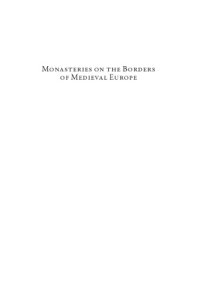
Ebook: Monasteries on the Borders of Medieval Europe: Conflict and Cultural Interaction
Author: Emilia Jamroziak, Karen Stöber
- Series: Medieval Church Studies 28
- Year: 2013
- Publisher: Brepols
- City: Turnhout
- Language: English
- pdf
As a historical and cultural phenomenon, monasticism always had a close connection with frontiers. The earliest monasteries were believed to be founded in wildernesses and deserts, thus existing beyond society and the inhabited world in general. As intercessors praying for their patrons and benefactors, monastic communities also existed on the border between the earthly and the spiritual worlds.
In medieval Europe, however, the frontier nature of monasticism had specific manifestations in addition to the founding myths of monastic wilderness. In the twelfth and thirteenth centuries the expansion of Latin Europe in East-Central Europe, the Iberian Peninsula, Scandinavia, and into the Holy Land and Greece opened possibilities for extending monastic networks and establishing new houses. One of the most important parts of this process was the interaction between these new religious communities and the social world around them - an interaction that was characterised by various shades of hostility, cooperation, and adaptation to the local social and cultural framework.
This is the first collection to consider the phenomenon of monastic frontiers in a cross-disciplinary manner. The book’s ten chapters explore the role of monasteries in maintaining political and cultural borders, in breaking and sustaining linguistic boundaries in late medieval Europe, as well as in building and stabilizing Latin Christian cultural identities on the northern and southern frontiers of Europe. Using a wide range of textual, archaeological, and material evidence, an international group of authors examines the expansion of monastic and mendicant networks in Scandinavia, Iberia, East-Central Europe, the British Isles, northern France, the Balkans, and Frankish Greece.
In medieval Europe, however, the frontier nature of monasticism had specific manifestations in addition to the founding myths of monastic wilderness. In the twelfth and thirteenth centuries the expansion of Latin Europe in East-Central Europe, the Iberian Peninsula, Scandinavia, and into the Holy Land and Greece opened possibilities for extending monastic networks and establishing new houses. One of the most important parts of this process was the interaction between these new religious communities and the social world around them - an interaction that was characterised by various shades of hostility, cooperation, and adaptation to the local social and cultural framework.
This is the first collection to consider the phenomenon of monastic frontiers in a cross-disciplinary manner. The book’s ten chapters explore the role of monasteries in maintaining political and cultural borders, in breaking and sustaining linguistic boundaries in late medieval Europe, as well as in building and stabilizing Latin Christian cultural identities on the northern and southern frontiers of Europe. Using a wide range of textual, archaeological, and material evidence, an international group of authors examines the expansion of monastic and mendicant networks in Scandinavia, Iberia, East-Central Europe, the British Isles, northern France, the Balkans, and Frankish Greece.
Download the book Monasteries on the Borders of Medieval Europe: Conflict and Cultural Interaction for free or read online
Continue reading on any device:

Last viewed books
Related books
{related-news}
Comments (0)